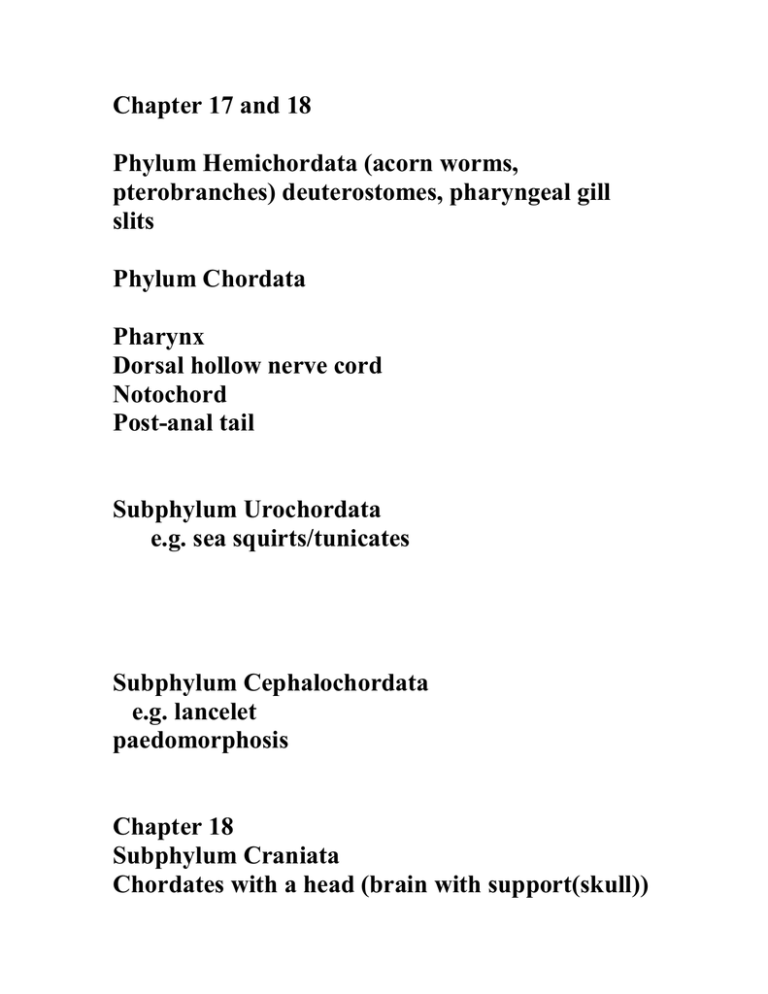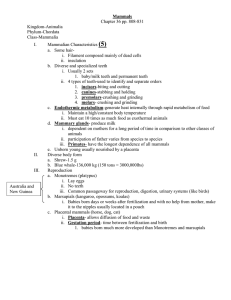Chapter 17 chordates.doc
advertisement

Chapter 17 and 18 Phylum Hemichordata (acorn worms, pterobranches) deuterostomes, pharyngeal gill slits Phylum Chordata Pharynx Dorsal hollow nerve cord Notochord Post-anal tail Subphylum Urochordata e.g. sea squirts/tunicates Subphylum Cephalochordata e.g. lancelet paedomorphosis Chapter 18 Subphylum Craniata Chordates with a head (brain with support(skull)) One kind of invertebrate craniate: hagfish Slime glands Jawless (agnathan) Lampreys are agnathans with a simple vertebral column Bloodsucking parasites on other fish Gnathostomes (jawed vertebrates) Opposable jaws are modified pharyngeal gill arches Class Chondrichthyes (cartilagenous fish: sharks, skates, rays, ratfish) Hard scales, shark teeth are scales Class Osteichthyes (bony fish: operculum (gill cover), swim bladder, usually a bony skeleton) Operculum used to maintain current of water over gills Bony fish in two major groups: Ray-finned fish (chondrosteans (includes sturgeon) and teleosts (big, big group)) lobe-finned fish (coelacanths and lungfish) the lobe-fin clade includes coelacanths, lungfish, and tetrapods transition to land air-breathing and legs Amniotes Diapsid branch Reptiles and Birds Synapsid branch Only extant members are mammals Mammals a) mammary glands (modified sweat glands) b) hair c) specialized teeth (within one mammals(e.g. incisors, molars, canines)) among different mammals (rodents and artiodactyl and primates all very different) d) legs oriented under the body (compared to reptiles with legs coming out at side) with mammals, the legs more directly support body weight e) endothermic/high metabolic rate three big groups of extant mammals 1) Monotremes (egg-laying mammals) platypus, echidna (all in Australia) 2) Marsupials (marsupium (pouch)) most found in Australia, some are found in South America and North America (opossum) 3) Eutherians (placental mammals) (extended period of development in uterus with placenta) Orders of eutherians a) Insectivora (shrews, moles, tenrecs, etc.) b) Chiroptera (bats, Microchiroptera (echolocation), Megachiroptera) c) Carnivora (diverse group, have carnassial teeth) know difference between a carnivore and a carnivoran (member of Order Carnivora) d)Perissodactyla (odd-toed hooved mammals; horses, rhinos, tapirs, zebras) e) Artiodactyla (even-toed hooved mammals) f) Cetacea (whales, dolphins, porpoises) toothed and baleen whales gXenarthra (few check teeth or no teeth; sloths, armadillos, giant anteaters) h) Lagomorpha (rabbits, hares, pikas) i) Rodentia (see textbook) incisors grow continuously, adaptation for gnawing j) Primates (prosimians, monkeys, apes (no tail)) hands for climbing, stereoscopic vision, large brains k) Proboscidea (elephants) l) Sirenia (manatees) Birds Archosaurs (dinosaurs, crocodilians) Flight Feathers (insulation and for flight) Forelimbs modified into wings Endothermic/high metabolic rate Honeycomb bones Beak (lighter than toothed jaw) Gizzard (internal chewing organ) Sternum is modified as a keel Forelimb muscles are relocated Feathers (contour ( a hard shaft, adapted for flight)) (down feathers, lack a hard shaft, adapted for insulation)




